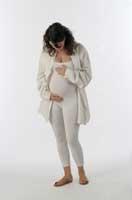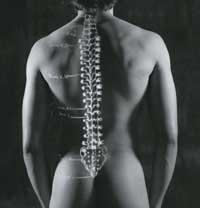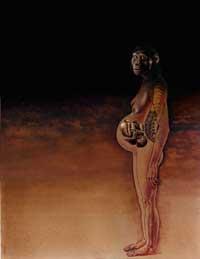The female spine adapted to pregnancy

Gravity does not benefit pregnant women. As the pregnancy progresses, the woman's gut weighs more and more, so the center of gravity advances. That is, if placed in the same position as when not pregnant, it would fall forward due to the weight of the gut. To avoid this, pregnant women bend their backs backwards (until diving reaches 28 degrees, according to this study).
The increased inclination of the back without pain is possible because in the lower part of the spine the woman's body presents a series of special features: on the one hand, the vertebrae that make it possible for the back to lean down the lumbar area are three in women and only two in men, allowing the tension resulting from the tilt to be distributed among more bones. On the other hand, the joints between these vertebrae are 14% higher in women to better maintain the strength to bear.

If a man had the gut of an pregnant woman, he would have much more back pain. After all, the muscles must maintain what the bones do not support. If the work done by the bones in women for as long as they are standing, the muscles would be affected.
Ancient adaptations
These adaptations are not new in women. The species of the genus Australopithecus that lived two million years ago already existed. Harvard researchers have concluded that they had to appear immediately after starting to walk to two legs.

When they started walking on two legs, the hands of the primates were free to perform various activities. But this new attitude became a problem for pregnant women. And imagine how long pregnant women had been. Until they started using contraceptives, in much of adulthood women were pregnant.
Imagine the life of a pregnant woman of the time: with a casing of about seven kilos, helped hunt, collected fruits, fled predators, etc. Those who are or have been in the ninth month of pregnancy already know ( and all who have not been you can imagine) how difficult it is to have to run with this type of guts. People who did not have the spine adapted to it would suffer many more back injuries to do the same. And, of course, a damaged back gives many more problems to move, either in search of food, or to escape predators.
Therefore, although evolution has no concrete intention, it is understandable that in the backbone of women these adaptations have spread very quickly from the moment they appeared. Those who had these adaptations would be much easier than those who didn't, and it can be thought that this increased women's survival. Thus, those women had more descendants than others and their daughters were born with them. Gradually, disadapted women were declining and, in some generations, the most adapted women were imposing themselves.
Published in 7K.
Buletina
Bidali zure helbide elektronikoa eta jaso asteroko buletina zure sarrera-ontzian











